It's not climate change that's causing heat waves this summer but no one wants to explain why
In the 1930s, the government's Heat Wave Index was four times higher
Commerce Secretary Gina Raimondo's talk interrupted by climate change protesters: video
A Wilson Center event featuring Commerce Secretary Gina Raimondo was cut short when a group of climate change protesters barged in and interrupted Raimondo, video shows.
Every summer, heat waves inevitably hit the U.S. and other parts of the world, causing climate alarmists and left-leaning media outlets to demand dramatic, disastrous changes to the global energy system. Unfortunately, this summer is no different.
On Tuesday, U.S. media outlets published a wave of stories about supposedly "historic" heat waves in Europe and North America. For example, The Washington Post published an article titled "Heat waves in U.S., Europe ‘virtually impossible’ without climate change, study finds."
Similarly, Axios published a story titled "Historic and enduring U.S. heat wave, by the numbers."
BARBIE'S DREAMHOUSE MUST BE 'REDESIGNED TO SURVIVE' CLIMATE CHANGE, CBS REPORTS
Although certain parts of the U.S. have undoubtedly experienced strong heat waves this summer, there’s no reason to believe these weather events are evidence that the world is hurtling toward a climate change catastrophe. In fact, the best available evidence suggests that heat waves recorded a century ago were more problematic than anything we’re seeing today.

Climate change protesters are seen marching and chanting as they carry placards in Melbourne, Australia, on Nov. 6, 2021. Protests across Australia were organized as part of a global day of action demanding world leaders act decisively on climate to prevent catastrophic global warming. (Asanka Ratnayake/Getty Images)
Government researchers have been tracking heat waves for more than 100 years. According to data from the U.S. Climate Change Science Program, which is made available by the Environmental Protection Agency, the annual heat wave index for the contiguous 48 states was substantially higher in the 1930s than at any point in recent years. In some years in the 1930s, it was four times greater or even more.
Additionally, the National Oceanic and Atmospheric Administration (NOAA) has a large database of daily temperatures that goes back to 1948. NOAA used 1,066 weather stations located across the U.S. to collect this data.
According to NOAA, huge swaths of the U.S. have experienced a significant decrease in abnormally hot days recorded since 1948, especially in the Midwest and northern and eastern Texas.
Although it’s true that some parts of the U.S. have seen the number of hotter-than-usual days increase over the past 70 years — including in California and the New York metropolitan area, both of which happen to be areas where a large number of media outlets are located — most weather stations have shown no meaningful changes or even declines.

U.S. Annual Heat Wave Index, 1895–2021 (EPA)
Meteorologist Anthony Watts, who works with me as a senior fellow at The Heartland Institute, analyzed NOAA’s data in detail and found that 81% of the weather stations used in NOAA’s database reported that since 1948 there has been "either a decrease or no change in the number of unusually hot days."
If the available data so clearly reveal that there is no heat-wave crisis, why are media outlets suggesting the opposite is true? The answer is sloppy, irresponsible media reporting, combined with cherry-picked data.
Anyone who wants to show a long-term warming or cooling trend can do so by selectively choosing starting and ending points in datasets that will provide the answer you’re looking for.
For instance, if you start your examination of historic temperatures with figures collected in the 1970s, when temperatures were unusually low compared to the rest of the century, then current temperatures look abnormally high.
If you start around 2010, then temperatures over the past decade appear to have dipped below "normal" and are only now recovering.
When many media outlets and left-wing politicians talk about climate change data, they almost always selectively choose a range that offers an incomplete picture of the larger available dataset. This makes it appear as though today’s temperatures are "historic" when they are actually well within normal historical ranges.
CLICK HERE TO GET THE OPINION NEWSLETTER
Another problem is that media outlets have been using temperature forecasts in their news reports as if those figures were actual temperature data. A forecast is, by definition, a guess, and some alarmist analysts have recently made a bad habit of incorrectly predicting insanely high temperatures that never come to fruition.
For example, the Telegraph, one of the largest papers in the U.K., published an article on July 18 in which the author claimed, "The European Space Agency said thermometers could tip 48C in Sardinia and Sicily, while the temperatures in Rome and Madrid could both reach the mid to high-40Cs. In drought-stricken Spain, temperatures were set to reach highs of 44C in Catalonia."
If the available data so clearly reveal that there is no heat-wave crisis, why are media outlets suggesting the opposite is true? The answer is sloppy, irresponsible media reporting, combined with cherry-picked data.
None of these predictions came true. In fact, some of them were off by several degrees or more.
CLICK HERE TO GET THE FOX NEWS APP
Heat waves happen every year, but this isn’t evidence that Americans are facing a global warming crisis. When heat-wave data are put into their proper historical context, it’s clear that everything humans are experiencing today has been witnessed in the past.
The ugly truth behind climate alarmism is that much of it is driven by a radical ideological agenda that is seeking to transform the global economy and American society, not by science. The best way to fight back against it is to use cold, hard facts. And those facts plainly show that there is no reason to panic about our ever-changing climate.



